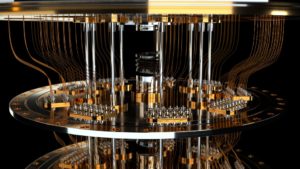Magnetic field sensing for active field cancellation in Quantum Computing
In many of the approaches used in quantum computing (QC), magnetic field variations are detrimental to the stability of the system.
Ways to manage external field disturbances range from passive shielding to active shielding using a sensor(s) to monitor the field close to the computer and control cancellation coils.
We present here some of the equipment which can be used for the different aspect of monitoring the magnetic field in and around a quantum computer.
For a number of QC methods, magnetic fields are required to be close to zero and stable over time. In Magneto-Optical Trap (MOT), a combination of laser and magnetic fields are used to cool and trap ions in a defined volume usually within high-vacuum chamber.
The center of the trap must be at null-field which is achieved by using a coil combination in an anti-Helmholtz configuration. However external field interferences need to be reduced as this could alter the null field.
In order to do this, large coils sit around the setup with a sensor located close to the vacuum chamber. The sensor will monitor for changes in the background field, with changes fed back to the power supply. Adjusting the current running through the compensation coils will allow to maintain the field to a required level.
Fluxgate sensors are ideal for this application. They will achieve nT sensitivity and could measure field up to 1mT enabling sitting them closer to the anti-Helmholtz coils if required. They can also be made to be vacuum compatible should they need to be placed inside the vacuum chamber.
For 3-axis measurement and feedback, the Mag-13 or the Mag690 will be perfectly suited, whilst the Mag612 may be convenient if there are space limitations to sit the fluxgate probe.
Similar cancellation requirement may also be applicable in annealing QC (as an alternative to passive shielding). Here, there may be some requirement for the sensing to take place in a cryogenic environment. In which case, the Mag-01H and F probes for single axis measurements, or the Cryomag™ for 3-axis field measurements.
Magnetic shield assessment in QC
In superconducting or annealing quantum computing, the qubits stability is sensitive to external magnetic fields.
Magnetic shields are used to isolate the quantum processor from the Earth’s magnetic field and its variations. Assessing the quality of the shield and its shielding factor can be done at room temperature using a three-axis fluxgate sensor. The Mag-13 offers the lowest offset and should therefore be preferred, though if access is limited, alternative sensors such as the Mag612 can be used.
The shield, which will likely be located in an environment which will be cooled down to low temperature, can also be assessed at low temperature using a cryogenic compatible sensor such as the Mag-01H and Mag F probe for single axis measurements, or the upcoming Cryomag™ 3-axis sensor.

